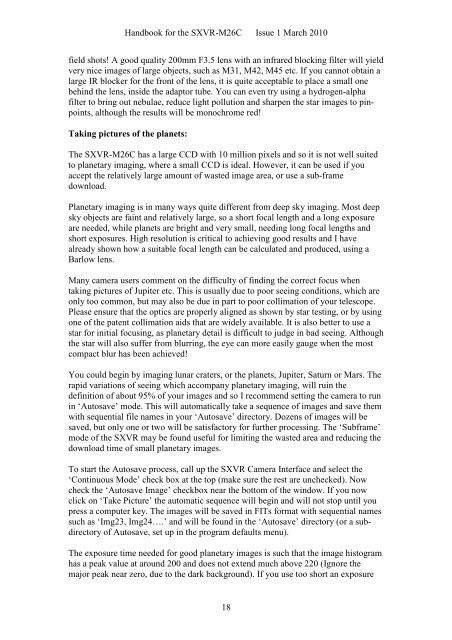SXVR-M26C handbook.pdf - Starlight Xpress
SXVR-M26C handbook.pdf - Starlight Xpress
SXVR-M26C handbook.pdf - Starlight Xpress
You also want an ePaper? Increase the reach of your titles
YUMPU automatically turns print PDFs into web optimized ePapers that Google loves.
Handbook for the <strong>SXVR</strong>-<strong>M26C</strong> Issue 1 March 2010<br />
field shots! A good quality 200mm F3.5 lens with an infrared blocking filter will yield<br />
very nice images of large objects, such as M31, M42, M45 etc. If you cannot obtain a<br />
large IR blocker for the front of the lens, it is quite acceptable to place a small one<br />
behind the lens, inside the adaptor tube. You can even try using a hydrogen-alpha<br />
filter to bring out nebulae, reduce light pollution and sharpen the star images to pinpoints,<br />
although the results will be monochrome red!<br />
Taking pictures of the planets:<br />
The <strong>SXVR</strong>-<strong>M26C</strong> has a large CCD with 10 million pixels and so it is not well suited<br />
to planetary imaging, where a small CCD is ideal. However, it can be used if you<br />
accept the relatively large amount of wasted image area, or use a sub-frame<br />
download.<br />
Planetary imaging is in many ways quite different from deep sky imaging. Most deep<br />
sky objects are faint and relatively large, so a short focal length and a long exposure<br />
are needed, while planets are bright and very small, needing long focal lengths and<br />
short exposures. High resolution is critical to achieving good results and I have<br />
already shown how a suitable focal length can be calculated and produced, using a<br />
Barlow lens.<br />
Many camera users comment on the difficulty of finding the correct focus when<br />
taking pictures of Jupiter etc. This is usually due to poor seeing conditions, which are<br />
only too common, but may also be due in part to poor collimation of your telescope.<br />
Please ensure that the optics are properly aligned as shown by star testing, or by using<br />
one of the patent collimation aids that are widely available. It is also better to use a<br />
star for initial focusing, as planetary detail is difficult to judge in bad seeing. Although<br />
the star will also suffer from blurring, the eye can more easily gauge when the most<br />
compact blur has been achieved!<br />
You could begin by imaging lunar craters, or the planets, Jupiter, Saturn or Mars. The<br />
rapid variations of seeing which accompany planetary imaging, will ruin the<br />
definition of about 95% of your images and so I recommend setting the camera to run<br />
in ‘Autosave’ mode. This will automatically take a sequence of images and save them<br />
with sequential file names in your ‘Autosave’ directory. Dozens of images will be<br />
saved, but only one or two will be satisfactory for further processing. The ‘Subframe’<br />
mode of the <strong>SXVR</strong> may be found useful for limiting the wasted area and reducing the<br />
download time of small planetary images.<br />
To start the Autosave process, call up the <strong>SXVR</strong> Camera Interface and select the<br />
‘Continuous Mode’ check box at the top (make sure the rest are unchecked). Now<br />
check the ‘Autosave Image’ checkbox near the bottom of the window. If you now<br />
click on ‘Take Picture’ the automatic sequence will begin and will not stop until you<br />
press a computer key. The images will be saved in FITs format with sequential names<br />
such as ‘Img23, Img24….’ and will be found in the ‘Autosave’ directory (or a subdirectory<br />
of Autosave, set up in the program defaults menu).<br />
The exposure time needed for good planetary images is such that the image histogram<br />
has a peak value at around 200 and does not extend much above 220 (Ignore the<br />
major peak near zero, due to the dark background). If you use too short an exposure<br />
18
















